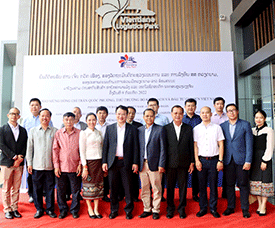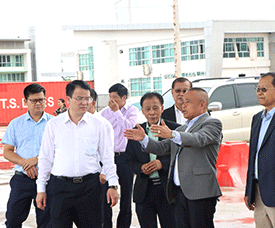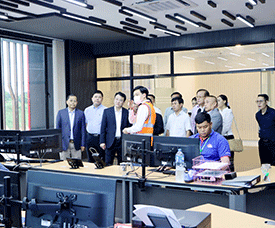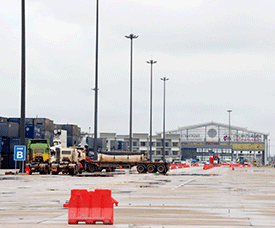Thanaleng Dry Port bolsters logistics services for Laos, Vung Ang seaport
The Vientiane Logistics Park and the associated Thanaleng Dry Port have improved Lao logistics services and will support the operations of the Vung Ang seaport in Vietnam, the Lao developer told the visiting Vietnamese deputy minister.
 |
| Mr Tran Quoc Phuong (fifth left), his entourage and Thanaleng Dry Port executives gather for a group photo. |
 |
| Mr Sakhone Philangam (second right) explains the project to Mr Tran Quoc Phuong. |
Vietnam’s Deputy Minister of Planning and Investment, Tran Quoc Phuong, and his entourage visited the landmark logistics park in Vientiane on Saturday.
Thanaleng Dry Port Managing Director Sakhone Philangam briefed the guests on the ways in which the pioneering infrastructure project are providing cost-effective logistics and transport services that benefit Laos, the region and beyond.
The logistics park and Vung Ang port in Vietnam’s central Ha Tinh province are part of the packaged Lao Logistics Link (LLL) project, which Petroleum Trading Lao Public Company (PetroTrade) has been granted permission to partner with the Lao and Vietnamese governments to develop.
Open for service since December 4, 2021, the dry port functions as an international checkpoint for freight imports and exports passing through Vientiane, Mr Sakhone said.
Through the Laos-China and Laos-Thailand railways, the dry port provides land-to-sea links to Myanmar, Thailand, Cambodia, Vietnam, Malaysia and beyond.
“Currently, products from China destined for Vietnam pass through the dry port,” Mr Sakhone told the Vietnamese delegation.
Once Laos takes over management of the Vung Ang port, and a planned railway (which is also part of the LLL project) to link Vientiane to the port is built, this will significantly improve Lao logistics services, the director said.
The government of Vietnam has agreed to increase Laos’ shareholding in the seaport from the current 20 percent to 60 percent. The two sides are assessing the value of the shares, to reach agreement before the share transfer takes place.The Lao investor told the guests that the Lao side expects to start construction of the Vientiane-Vung Ang Railway’s section connecting Thakhaek (the capital of Khammuan province) to the Laos-Vietnam border by the end of this year.
“When we have (assumed management of) the Vung Ang port and the Vung Ang-Thakhaek railway is complete, it will take Lao logistics services to new heights,” he said.
Thanks to its sound business model, the logistics park and dry port have received financial support from the International Finance Corporation — a sister organisation of the World Bank and member of the World Bank
 |
| Mr Tran Quoc Phuong (third left) and his team visit the dry port operations room. |
 |
| The Laos-China 1.435 metre gauge rail track and the Laos-Thailand one-metre gauge track are extended inside the dry port to facilitate transport. |
 |
| The container yard at the dry port. |
Group - which will amount to more than US$500 million.
The funding will enable the upgrade of the dry port to meet the standards set by Asean, the regional 10-member bloc of which Laos is a part, so that the dry port becomes a logistics hub connecting Asean and Europe.
Containers shipped from Southeast Asia by rail via the dry port could reach European markets within about 14 days. This is much shorter than transport by sea, which takes about 45 days, and would cut transport costs by up to about 40 percent.
Over the first four months of this year, the dry port provided import-export and transit shipment services for 11,092 twenty-foot equivalent units (TEU), mostly carried by rail.
Of the total TEUs, 85 percent contained goods for import and export across the Laos-China border, 14 percent involved imports and exports across the Laos-Thailand border, and the remaining one percent was shipped directly through Thailand’s and China’s railways.
The Vietnamese deputy minister said he was impressed by the project and that it would make a great contribution to the socio-economic development of Laos.
“Once the project is fully complete, I think it will be most effective for Lao economic development and attract more foreign investment,” Mr Phuong said through an interpreter.
He noted that the logistics park is offering conditions that are conducive to attracting foreign investment.
The US$727 million project offers investment opportunities through its various investment zones, which are being built on 382 hectares of land.
These zones include the Thanaleng Dry Port - the centre of international import and export trade with all categories of customs operations; a Tank Farm - a fuel distribution centre for Laos; the Logistics Park - a warehousing and distribution centre; a Free Trade Zone; and an Export Processing Zone.
By Advertorial Desk
(Latest Update July 11, 2022)
|